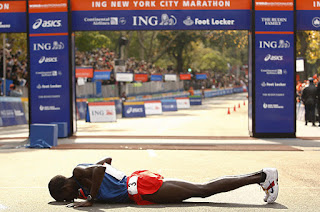
James Tiga takes a resting moment on the spot of his finished race. Tiga has been competing in marathons for the past 10 years and is working his way up to the olympics.

Over 60 white ducks are set free after 6 months in a sanctuary. The Steinle Sanctuary is a testing lab for animals, where the 60 ducks were held.
Photography rules:
1. Rule of thirds- instead of centering the photo, imagine a tic tac toe box in the photo and make the subject on one of the intersection points.
2. Balancing elements- when having two subjects/objects, try creating an equal space between them in the center of the photo.
3. Leading lines- getting lines in the photograph draws peoples eyes to the main object at the end
4. Symmetry and patterns- getting shapes in the photo or getting a symmetric theme in the photo.
5. Viewpoint- the angle you take the photo at. Instead of always doing eye level try above or below the object/subject.
6. Background- focusing the image on background forces.
7. Create depth- shooting the image from a normally low point of view. layers of different objects, ex: mountains
8. Framing- using shadows or background to create like a barrier around your photo.
9. Cropping- fitting your image to the page.
10- Avoiding Mergers- making sure to not get the same colors layered on top of each other or cutting out an important part to something.
3.
Aperture- the space that light passes through in a camera.
Shutter speed- how fast the camera exposes and closes the film.
ISO- measures sensitivity of the image sensor. lower setting= less sensitive to light, finer grain. higher setting= used in darker places to get faster shutter speeds.
4. Whats acceptable in manipulating photos in photoshop is changing the light setting so you can clearly see the photo and cropping the photo. Unacceptable would be reshaping objects ect.
5. Portraits
Environmental- the main person is doing something.
Self- focus is on the person.
Casual- not really perfect or planned.
(Formal- set up, planned; Informal- Candid, not perfect)
6.
Exposure- amount of light per unit area hitting the film.
Depth of Field- the difference between the nearest and farthest object in the photo that appear sharp.
Focal Length- the distance between the lens and the image sensor when the object is in focus.
No comments:
Post a Comment